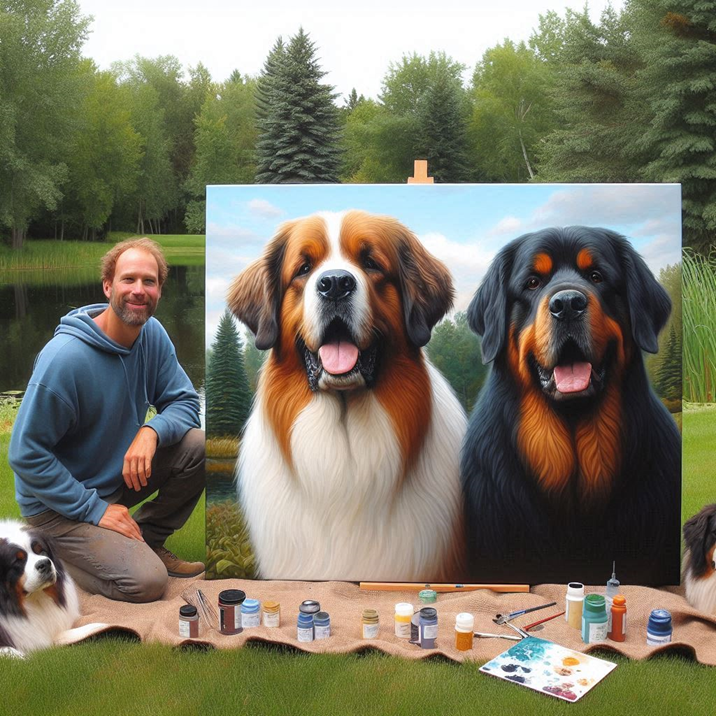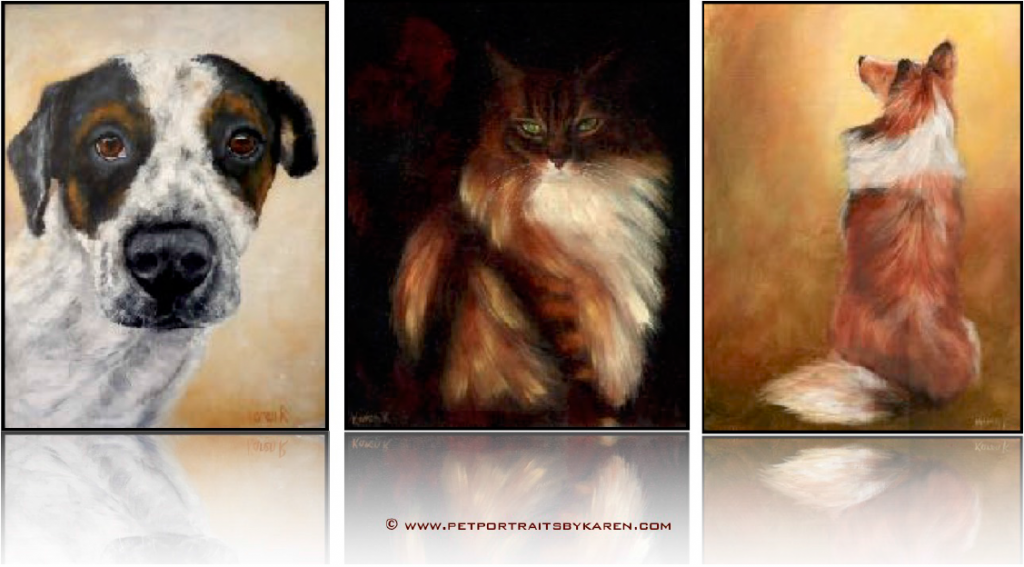Pet Portrait Artists by Karen Robinson, Pet Portrait Artist – Devon, UK.
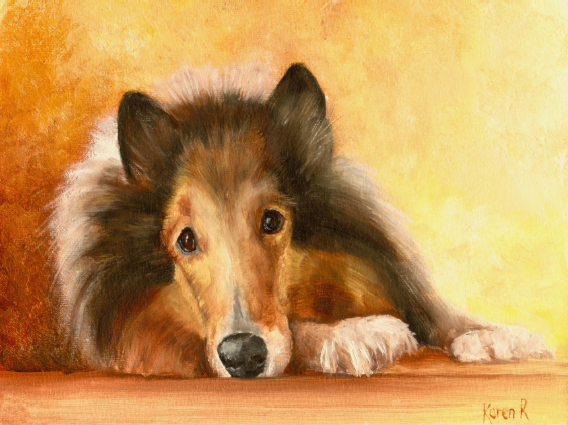
Pet Portrait Artists
There are many reasons why you may decide to commission an artist to paint your pet. After all, the earliest paintings we have any record of were made by our ancestors of animals on the walls of their homes (caves).
Petworks has hundreds of talented pet portrait artists you can hire. Here are a few tips if you are considering asking an artist to create a painting or drawing of your own.
The Artist’s Style
Look at as many examples of artists’ work as you can. When you find some work that clicks with you, ask the artist to send you more images to view if necessary to help you choose. The most important thing is that you like what you see! There are many artists offering to paint your pet all around the world so you, the pet parent, have a huge amount of choice. You do not need to commission the first artist you find.
The Art: Size and Medium
Consider what size you wish to commission. Price is not the only consideration: if an artist, whose work you have decided you like, paints 4 ft x 4ft canvases and you live in a tiny apartment you may wish to reconsider. “Can you do one like this but much smaller?” is not likely to work well!
The Most Common Mediums…
…for pet portraits are: oils, watercolors, pastel and graphite (pencil). Paintings in oil – the traditional medium – are usually more expensive than other mediums and take longer to create. Beautiful work can be found in watercolor, and pastel is a medium that allows for highly realistic rendering of fur. Both of these mediums need to be framed behind glass before hanging, whereas oil paintings do not.
Here are 4 examples, from left to right: graphite, pastel, watercolor, oil:
Working With The Artist
It is obviously very helpful if you feel comfortable working with the pet portrait artist, and are at ease in your discussions with her about your requirements.
This is what you have a right to expect from the artist:
- A clear, written statement of what your art work will cost you and the terms and conditions surrounding payment, including shipping cost (if applicable).
- Most artists will ask you to pay a deposit of 20-50% of the agreed price up front before they begin work. The balance becomes payable when you approve the completed work.
- Artists working in oils will usually price their work excluding the cost of a frame.
- Artists working in pastel, pencil and watercolor will sometimes price to include the frame, because it is essential that these media are framed to protect them.
- Make sure you are clear what is included in your quote.
- Unless you have specified and agreed with the artist very clearly what you expect the finished painting to look like (e.g. “I want one of my dog that looks just like THIS” with an example of what you mean), then you should expect a clear description, or better still a visual (such as a rough working sketch) of what your painting is likely to look like. At the very least, you should know whether the painting will be portrait, (on the left) or landscape (on the right) and what size it will be.
- An indication of how long your painting is likely to take to complete (or to start, if the artist has a waiting list).
This is what the artist is likely to expect from you:
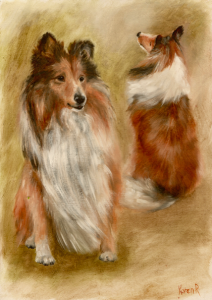 A clear idea of which pet or pets you want the artist to paint: “adding in” an extra one half way through is unlikely to be possible, especially if the pets are very different sizes. Tell the artist all the important points that will ‘make or break’ the painting for you. For example, if you provide the artist with a photograph of your dog wearing a collar but do not want the collar included in the final painting; if you need the background of the painting to “match” your room’s wallpaper or paint color; if you want the painting to be the same size and shape as one you will be hanging it alongside. Good quality reference photographs to work from. It is unlikely the artist will work from life – although sometimes artists will sketch the animal from life if this is practicable. Most of my customers live in a different country to me, usually a different continent – so I always work from photographs. This is so significant to the quality of the finished piece, here are a few tips specifically about photographs.
A clear idea of which pet or pets you want the artist to paint: “adding in” an extra one half way through is unlikely to be possible, especially if the pets are very different sizes. Tell the artist all the important points that will ‘make or break’ the painting for you. For example, if you provide the artist with a photograph of your dog wearing a collar but do not want the collar included in the final painting; if you need the background of the painting to “match” your room’s wallpaper or paint color; if you want the painting to be the same size and shape as one you will be hanging it alongside. Good quality reference photographs to work from. It is unlikely the artist will work from life – although sometimes artists will sketch the animal from life if this is practicable. Most of my customers live in a different country to me, usually a different continent – so I always work from photographs. This is so significant to the quality of the finished piece, here are a few tips specifically about photographs.
- Try to familiarize your pet with the camera, especially dogs as some dogs may find the camera confrontational.
- Have an assistant if possible. They can help keep your pet in one place and looking in the right direction, whilst you concentrate on getting the shot. A supply of dog treats and a few favorite toys, such as a ball if you’re after an action shot, or a squeaky toy for grabbing attention, will come in useful.
- You’ll need a background as clutter free as possible so as not to cause a distraction from your pet. A plain sheet simply draped over a chair might do the trick. Think about the main color of your pet’s fur, especially if it is very dark (black) or very light (white). For example, If you have a white dog, don’t sit him against a white sheet but choose a darker color/fabric so it is possible for the artist to see where the dog ends and the background begins.
- Try not to photograph your pet looking down from a standing position, try to get down to their eye level for a more engaging image. If the pet is tiny, place him on something higher up so that you can look into his eyes.
- If there is something specific you want in the background of your painting, you can send a separate photograph of that, you do not have to try and get the perfect shot that includes both the dog and the item. Just remember to
photograph whatever the item is from the same level (position) that you photographed the pet. - Remember that artists paint what they see – when I am painting a pet to commission, I am painting one particular pet – YOUR pet – not just any pet. So I cannot “make things up”. For example, If you want a full body painting I cannot do it if you send me a photograph only of a head. Or, if you would like all four of your dog’s paws in the portrait, please do not “cut them off” on the photo.
FINALLY…About Pet Portrait Artists…
A painting of your pet is a very personal and individual piece and cannot simply be bought off the shelf. Be willing to engage with the artist and answer any questions she may have. An artist who specializes in painting animals will want to get to know your pet through your words and your photos and will want to delight you with their work. Have fun with your commission and enjoy the process – the finished painting will be well worth the time!
Author Bio:
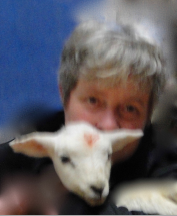 Karen Robinson paints from her home on the Devon/Cornwall border, looking out over her easel across open fields. Usually there are sheep or other livestock peacefully grazing, sometimes rabbits, often pheasants. In summer there will be flocks of swallows and house martins gathering mud for their nests and, in winter, murmurations of starlings.
Karen Robinson paints from her home on the Devon/Cornwall border, looking out over her easel across open fields. Usually there are sheep or other livestock peacefully grazing, sometimes rabbits, often pheasants. In summer there will be flocks of swallows and house martins gathering mud for their nests and, in winter, murmurations of starlings.
Karen came late to painting after many years of raising children and earning a living in other ways. Practicing for many years as a textile and fiber artist, the move to traditional art media came about because she could no longer achieve in stitch the degree of realism and expression she sought. She found herself stitching less and painting on to the fabric more.
Inspiration comes from the world around her and the work of many realist painters from Velasquez to John Singer Sargent, but especially master animal artists: Sir Edwin Landseer, John Emms, Rosa Bonheur.
Special mention must be made of her dog, Bilbo Baggins, who was her first model and continues to be her Muse. Karen’s paintings hang in homes around the world, including Europe, Scandinavia almost all the States of the USA.
 In 2021, Dr. Marty Goldstein DVM joined the pet care platform Petworks as an advisor in its Animal Nutrition care division. Dr Marty Nature’s Blend is on a mission to help your pets live their healthiest lives possible. Dr. Marty’s pet nutrition expertise and guidance has helped Petworks evolve and become the preeminent animal and pet nutrition consultation service for pet parents in North America.
In 2021, Dr. Marty Goldstein DVM joined the pet care platform Petworks as an advisor in its Animal Nutrition care division. Dr Marty Nature’s Blend is on a mission to help your pets live their healthiest lives possible. Dr. Marty’s pet nutrition expertise and guidance has helped Petworks evolve and become the preeminent animal and pet nutrition consultation service for pet parents in North America.
 In 2022, Blue Buffalo Founder Bill Bishop Jr. joined Petworks as Senior Advisor in our Animal Nutrition Care Division. Bill brings his extensive expertise in pet food innovation and business leadership. His guidance helps Petworks enhance our pet nutrition service offerings, helping to ensure that pet parents throughout the world receive trusted, science-backed nutritional support for their dogs, cats, and animals.
In 2022, Blue Buffalo Founder Bill Bishop Jr. joined Petworks as Senior Advisor in our Animal Nutrition Care Division. Bill brings his extensive expertise in pet food innovation and business leadership. His guidance helps Petworks enhance our pet nutrition service offerings, helping to ensure that pet parents throughout the world receive trusted, science-backed nutritional support for their dogs, cats, and animals.
 Petworks Co-Founder Kevin Kinyon is a life-long animal lover who works tirelessly to improve the lives of pets and their parents. Human and animal qualities he values most are integrity, humor, and empathy.
Petworks Co-Founder Kevin Kinyon is a life-long animal lover who works tirelessly to improve the lives of pets and their parents. Human and animal qualities he values most are integrity, humor, and empathy.

